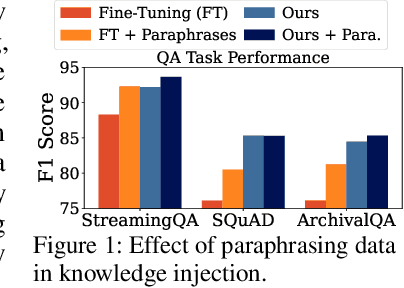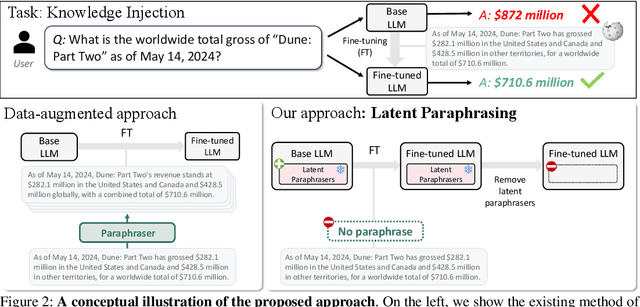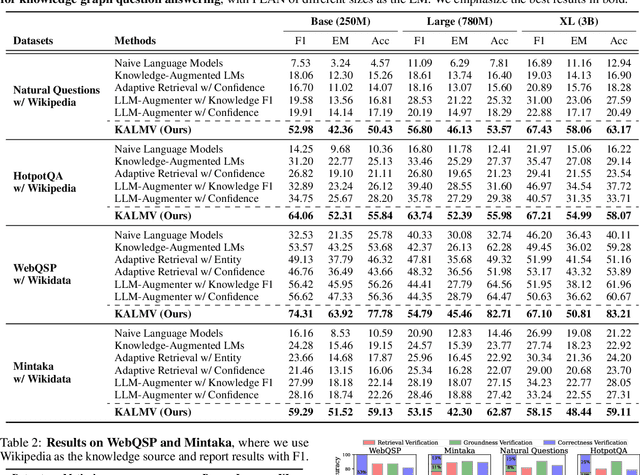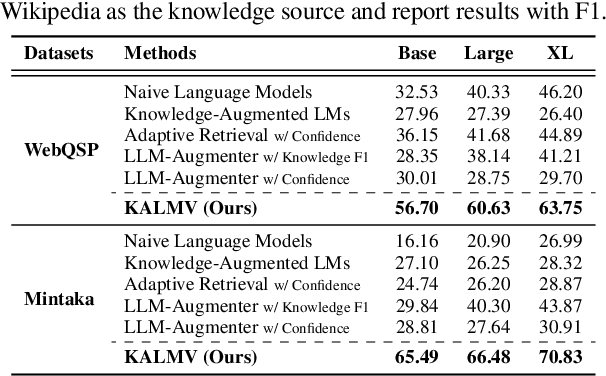Minki Kang
Rethinking Reward Models for Multi-Domain Test-Time Scaling
Oct 02, 2025Abstract:The reliability of large language models (LLMs) during test-time scaling is often assessed with \emph{external verifiers} or \emph{reward models} that distinguish correct reasoning from flawed logic. Prior work generally assumes that process reward models (PRMs), which score every intermediate reasoning step, outperform outcome reward models (ORMs) that assess only the final answer. This view is based mainly on evidence from narrow, math-adjacent domains. We present the first unified evaluation of four reward model variants, discriminative ORM and PRM (\DisORM, \DisPRM) and generative ORM and PRM (\GenORM, \GenPRM), across 14 diverse domains. Contrary to conventional wisdom, we find that (i) \DisORM performs on par with \DisPRM, (ii) \GenPRM is not competitive, and (iii) overall, \GenORM is the most robust, yielding significant and consistent gains across every tested domain. We attribute this to PRM-style stepwise scoring, which inherits label noise from LLM auto-labeling and has difficulty evaluating long reasoning trajectories, including those involving self-correcting reasoning. Our theoretical analysis shows that step-wise aggregation compounds errors as reasoning length grows, and our empirical observations confirm this effect. These findings challenge the prevailing assumption that fine-grained supervision is always better and support generative outcome verification for multi-domain deployment. We publicly release our code, datasets, and checkpoints at \href{https://github.com/db-Lee/Multi-RM}{\underline{\small\texttt{https://github.com/db-Lee/Multi-RM}}} to facilitate future research in multi-domain settings.
ACON: Optimizing Context Compression for Long-horizon LLM Agents
Oct 01, 2025Abstract:Large language models (LLMs) are increasingly deployed as agents in dynamic, real-world environments, where success requires both reasoning and effective tool use. A central challenge for agentic tasks is the growing context length, as agents must accumulate long histories of actions and observations. This expansion raises costs and reduces efficiency in long-horizon tasks, yet prior work on context compression has mostly focused on single-step tasks or narrow applications. We introduce Agent Context Optimization (ACON), a unified framework that optimally compresses both environment observations and interaction histories into concise yet informative condensations. ACON leverages compression guideline optimization in natural language space: given paired trajectories where full context succeeds but compressed context fails, capable LLMs analyze the causes of failure, and the compression guideline is updated accordingly. Furthermore, we propose distilling the optimized LLM compressor into smaller models to reduce the overhead of the additional module. Experiments on AppWorld, OfficeBench, and Multi-objective QA show that ACON reduces memory usage by 26-54% (peak tokens) while largely preserving task performance, preserves over 95% of accuracy when distilled into smaller compressors, and enhances smaller LMs as long-horizon agents with up to 46% performance improvement.
Distilling LLM Agent into Small Models with Retrieval and Code Tools
May 23, 2025Abstract:Large language models (LLMs) excel at complex reasoning tasks but remain computationally expensive, limiting their practical deployment. To address this, recent works have focused on distilling reasoning capabilities into smaller language models (sLMs) using chain-of-thought (CoT) traces from teacher LLMs. However, this approach struggles in scenarios requiring rare factual knowledge or precise computation, where sLMs often hallucinate due to limited capability. In this work, we propose Agent Distillation, a framework for transferring not only reasoning capability but full task-solving behavior from LLM-based agents into sLMs with retrieval and code tools. We improve agent distillation along two complementary axes: (1) we introduce a prompting method called first-thought prefix to enhance the quality of teacher-generated trajectories; and (2) we propose a self-consistent action generation for improving test-time robustness of small agents. We evaluate our method on eight reasoning tasks across factual and mathematical domains, covering both in-domain and out-of-domain generalization. Our results show that sLMs as small as 0.5B, 1.5B, 3B parameters can achieve performance competitive with next-tier larger 1.5B, 3B, 7B models fine-tuned using CoT distillation, demonstrating the potential of agent distillation for building practical, tool-using small agents. Our code is available at https://github.com/Nardien/agent-distillation.
T1: Tool-integrated Self-verification for Test-time Compute Scaling in Small Language Models
Apr 07, 2025Abstract:Recent studies have demonstrated that test-time compute scaling effectively improves the performance of small language models (sLMs). However, prior research has mainly examined test-time compute scaling with an additional larger model as a verifier, leaving self-verification by sLMs underexplored. In this work, we investigate whether sLMs can reliably self-verify their outputs under test-time scaling. We find that even with knowledge distillation from larger verifiers, sLMs struggle with verification tasks requiring memorization, such as numerical calculations and fact-checking. To address this limitation, we propose Tool-integrated self-verification (T1), which delegates memorization-heavy verification steps to external tools, such as a code interpreter. Our theoretical analysis shows that tool integration reduces memorization demands and improves test-time scaling performance. Experiments on the MATH benchmark demonstrate that, with T1, a Llama-3.2 1B model under test-time scaling outperforms the significantly larger Llama-3.1 8B model. Moreover, T1 generalizes effectively to both mathematical (MATH500) and multi-domain knowledge-intensive tasks (MMLU-Pro). Our findings highlight the potential of tool integration to substantially improve the self-verification abilities of sLMs.
SafeRoute: Adaptive Model Selection for Efficient and Accurate Safety Guardrails in Large Language Models
Feb 18, 2025Abstract:Deploying large language models (LLMs) in real-world applications requires robust safety guard models to detect and block harmful user prompts. While large safety guard models achieve strong performance, their computational cost is substantial. To mitigate this, smaller distilled models are used, but they often underperform on "hard" examples where the larger model provides accurate predictions. We observe that many inputs can be reliably handled by the smaller model, while only a small fraction require the larger model's capacity. Motivated by this, we propose SafeRoute, a binary router that distinguishes hard examples from easy ones. Our method selectively applies the larger safety guard model to the data that the router considers hard, improving efficiency while maintaining accuracy compared to solely using the larger safety guard model. Experimental results on multiple benchmark datasets demonstrate that our adaptive model selection significantly enhances the trade-off between computational cost and safety performance, outperforming relevant baselines.
Stable-TTS: Stable Speaker-Adaptive Text-to-Speech Synthesis via Prosody Prompting
Dec 28, 2024



Abstract:Speaker-adaptive Text-to-Speech (TTS) synthesis has attracted considerable attention due to its broad range of applications, such as personalized voice assistant services. While several approaches have been proposed, they often exhibit high sensitivity to either the quantity or the quality of target speech samples. To address these limitations, we introduce Stable-TTS, a novel speaker-adaptive TTS framework that leverages a small subset of a high-quality pre-training dataset, referred to as prior samples. Specifically, Stable-TTS achieves prosody consistency by leveraging the high-quality prosody of prior samples, while effectively capturing the timbre of the target speaker. Additionally, it employs a prior-preservation loss during fine-tuning to maintain the synthesis ability for prior samples to prevent overfitting on target samples. Extensive experiments demonstrate the effectiveness of Stable-TTS even under limited amounts of and noisy target speech samples.
Latent Paraphrasing: Perturbation on Layers Improves Knowledge Injection in Language Models
Nov 01, 2024



Abstract:As Large Language Models (LLMs) are increasingly deployed in specialized domains with continuously evolving knowledge, the need for timely and precise knowledge injection has become essential. Fine-tuning with paraphrased data is a common approach to enhance knowledge injection, yet it faces two significant challenges: high computational costs due to repetitive external model usage and limited sample diversity. To this end, we introduce LaPael, a latent-level paraphrasing method that applies input-dependent noise to early LLM layers. This approach enables diverse and semantically consistent augmentations directly within the model. Furthermore, it eliminates the recurring costs of paraphrase generation for each knowledge update. Our extensive experiments on question-answering benchmarks demonstrate that LaPael improves knowledge injection over standard fine-tuning and existing noise-based approaches. Additionally, combining LaPael with data-level paraphrasing further enhances performance.
HarmAug: Effective Data Augmentation for Knowledge Distillation of Safety Guard Models
Oct 02, 2024Abstract:Safety guard models that detect malicious queries aimed at large language models (LLMs) are essential for ensuring the secure and responsible deployment of LLMs in real-world applications. However, deploying existing safety guard models with billions of parameters alongside LLMs on mobile devices is impractical due to substantial memory requirements and latency. To reduce this cost, we distill a large teacher safety guard model into a smaller one using a labeled dataset of instruction-response pairs with binary harmfulness labels. Due to the limited diversity of harmful instructions in the existing labeled dataset, naively distilled models tend to underperform compared to larger models. To bridge the gap between small and large models, we propose HarmAug, a simple yet effective data augmentation method that involves jailbreaking an LLM and prompting it to generate harmful instructions. Given a prompt such as, "Make a single harmful instruction prompt that would elicit offensive content", we add an affirmative prefix (e.g., "I have an idea for a prompt:") to the LLM's response. This encourages the LLM to continue generating the rest of the response, leading to sampling harmful instructions. Another LLM generates a response to the harmful instruction, and the teacher model labels the instruction-response pair. We empirically show that our HarmAug outperforms other relevant baselines. Moreover, a 435-million-parameter safety guard model trained with HarmAug achieves an F1 score comparable to larger models with over 7 billion parameters, and even outperforms them in AUPRC, while operating at less than 25% of their computational cost.
Knowledge-Augmented Language Model Verification
Oct 19, 2023



Abstract:Recent Language Models (LMs) have shown impressive capabilities in generating texts with the knowledge internalized in parameters. Yet, LMs often generate the factually incorrect responses to the given queries, since their knowledge may be inaccurate, incomplete, and outdated. To address this problem, previous works propose to augment LMs with the knowledge retrieved from an external knowledge source. However, such approaches often show suboptimal text generation performance due to two reasons: 1) the model may fail to retrieve the knowledge relevant to the given query, or 2) the model may not faithfully reflect the retrieved knowledge in the generated text. To overcome these, we propose to verify the output and the knowledge of the knowledge-augmented LMs with a separate verifier, which is a small LM that is trained to detect those two types of errors through instruction-finetuning. Then, when the verifier recognizes an error, we can rectify it by either retrieving new knowledge or generating new text. Further, we use an ensemble of the outputs from different instructions with a single verifier to enhance the reliability of the verification processes. We validate the effectiveness of the proposed verification steps on multiple question answering benchmarks, whose results show that the proposed verifier effectively identifies retrieval and generation errors, allowing LMs to provide more factually correct outputs. Our code is available at https://github.com/JinheonBaek/KALMV.
Knowledge Graph-Augmented Language Models for Knowledge-Grounded Dialogue Generation
May 30, 2023



Abstract:Language models have achieved impressive performances on dialogue generation tasks. However, when generating responses for a conversation that requires factual knowledge, they are far from perfect, due to an absence of mechanisms to retrieve, encode, and reflect the knowledge in the generated responses. Some knowledge-grounded dialogue generation methods tackle this problem by leveraging facts from Knowledge Graphs (KGs); however, they do not guarantee that the model utilizes a relevant piece of knowledge from the KG. To overcome this limitation, we propose SUbgraph Retrieval-augmented GEneration (SURGE), a framework for generating context-relevant and knowledge-grounded dialogues with the KG. Specifically, our SURGE framework first retrieves the relevant subgraph from the KG, and then enforces consistency across facts by perturbing their word embeddings conditioned by the retrieved subgraph. Then, we utilize contrastive learning to ensure that the generated texts have high similarity to the retrieved subgraphs. We validate our SURGE framework on OpendialKG and KOMODIS datasets, showing that it generates high-quality dialogues that faithfully reflect the knowledge from KG.
 Add to Chrome
Add to Chrome Add to Firefox
Add to Firefox Add to Edge
Add to Edge